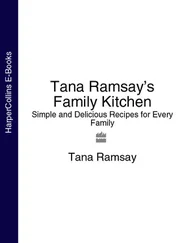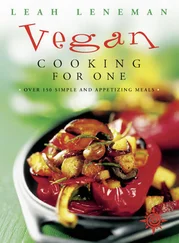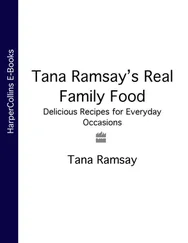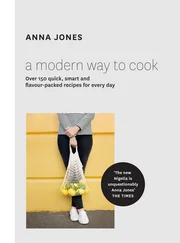 Many cookery books state that imperial and metric measurements should not be mixed. As far as I am concerned, the recipes in this book are robust enough for imperial, metric and American measurements to be mixed at will. This is home cooking, not biochemistry.
Many cookery books state that imperial and metric measurements should not be mixed. As far as I am concerned, the recipes in this book are robust enough for imperial, metric and American measurements to be mixed at will. This is home cooking, not biochemistry.
 Onions and other vegetables are assumed to be ‘medium-sized’ unless otherwise stated.
Onions and other vegetables are assumed to be ‘medium-sized’ unless otherwise stated.
 Breadcrumbs are always fresh. I never use dried ones since I always keep sliced bread in the freezer which defrosts very quickly.
Breadcrumbs are always fresh. I never use dried ones since I always keep sliced bread in the freezer which defrosts very quickly.
 It is a good idea to cook double quantities of rice and potatoes and refrigerate half; many of my recipes call for cooked rice or potatoes.
It is a good idea to cook double quantities of rice and potatoes and refrigerate half; many of my recipes call for cooked rice or potatoes.
 When a recipe calls for mashed potato that means mashed with a little soya (soy) milk and vegan margarine added. Many dried mashed potato mixes are vegan; they contain undesirable additives, but the time they can save may justify their occasional use.
When a recipe calls for mashed potato that means mashed with a little soya (soy) milk and vegan margarine added. Many dried mashed potato mixes are vegan; they contain undesirable additives, but the time they can save may justify their occasional use.
 For deep frying I strongly recommend a deep-fat fryer for both health and safety reasons. It heats the oil to the right temperature so that the food immediately seals up and does not absorb the oil.
For deep frying I strongly recommend a deep-fat fryer for both health and safety reasons. It heats the oil to the right temperature so that the food immediately seals up and does not absorb the oil.
 It will be clear that eggs are not a necessary item in cooking, but if you want to use existing recipes that call for egg as a binder, the American-made Ener-G Egg Replacer is vegan and available at most health food stores. Mayonnaise, which traditionally contains eggs, is readily available in vegan form at all British health food stores. A recipe for a homemade vegan version is in The Tofu Cookbook by Leah Leneman.
It will be clear that eggs are not a necessary item in cooking, but if you want to use existing recipes that call for egg as a binder, the American-made Ener-G Egg Replacer is vegan and available at most health food stores. Mayonnaise, which traditionally contains eggs, is readily available in vegan form at all British health food stores. A recipe for a homemade vegan version is in The Tofu Cookbook by Leah Leneman.
 American readers may be puzzled by the ingredient ‘yeast extract’ while British readers might be puzzled by ‘nutritional yeast’. Yeast extract is a salty brown paste which some American health food stores stock, most likely under its Australian brand name of Vegemite. If it cannot be found then soy sauce may be substituted, though the flavour will be different. Nutritional yeast comes in powdered or flaked form and is sold in British health food stores under the ‘Engevita’ brand.
American readers may be puzzled by the ingredient ‘yeast extract’ while British readers might be puzzled by ‘nutritional yeast’. Yeast extract is a salty brown paste which some American health food stores stock, most likely under its Australian brand name of Vegemite. If it cannot be found then soy sauce may be substituted, though the flavour will be different. Nutritional yeast comes in powdered or flaked form and is sold in British health food stores under the ‘Engevita’ brand.
 Microwaves are marvellous for speeding up dishes that would traditionally be cooked in the oven or steamed. Timings are given for a 750 watt appliance and should be extended for a 650 one and reduced for an 850 one. Always check that a dish is heated right through before serving. Note that, unlike dishes cooked in any other way, which take the same time even if a recipe is halved or quartered, microwave times need to be cut down in proportion if a smaller amount is made.
Microwaves are marvellous for speeding up dishes that would traditionally be cooked in the oven or steamed. Timings are given for a 750 watt appliance and should be extended for a 650 one and reduced for an 850 one. Always check that a dish is heated right through before serving. Note that, unlike dishes cooked in any other way, which take the same time even if a recipe is halved or quartered, microwave times need to be cut down in proportion if a smaller amount is made.
Adult animals have no need for milk, either their own or that of another species, but in the western world people have become so accustomed to cows’ milk and the products made from it that it becomes difficult to imagine a diet without such foods. Thus, while there is no physical need for dairy products – in the Far East much of the population is lactose-intolerant and never uses milk – the dishes which have evolved in the west require substitutes.
Over the past decade the growth in soya (soy) milks available has grown astonishingly, with some supermarkets offering own brand products. Although the ingredients on the different cartons appear similar, they are actually quite different in taste so if you try soya (soy) milk for the first time and don’t like it then do try other brands. Soya (soy) milks are available either unsweetened or sweetened; I must admit to finding the former much more palatable than the latter.
Soya (soy) milks can be added to tea or coffee: they will curdle slightly but that does not affect the taste. An alternative is a true non-dairy creamer (but note that the so-called non-dairy creamers sold in supermarkets actually contain casein, a dairy derivative), which can be found in Jewish delicatessens.
This recipe is for those who wish to make their own soya (soy) milks at home, although with such a choice now available few people need to.
1) Bring about 570ml (1 pint/2½cups) of water to the boil, add 115g (4 oz) soya (soy) beans, boil for 1 minute, then remove from the heat, cover and leave to soak overnight.
2) Drain the beans and wash them thoroughly. Put 1 cupful of beans in a liquidizer, add about 570ml (1 pint/2½cups) of hot water and blend them thoroughly. Pour through a clean tea towel (dish towel) or muslin, squeezing to extract all the liquid (the pulp can be used for savoury dishes if desired). Repeat until all the beans are used up.
3) Bring the milk to the boil, stirring frequently. (It has a tendency both to burn on the bottom of the pan and to boil over if not watched carefully.)
4) Simmer the milk over the lowest possible heat for 15–20 minutes. Set aside to cool and then keep in the refrigerator.
5) This can be made more palatable by adding pure vanilla essence or sweetening to taste.
In southern Spain a popular summer drink is horchata, which is basically a nut milk. A milk made from either cashews or almonds is very pleasant over cereal. This recipe can be made thicker or thinner, if preferred, by increasing or decreasing the proportion of nuts and oil to water.
115g/4 oz/¾ cup cashews or blanched
almonds
285ml/ 1/ 2pt/1 1/ 3cups water as required raw cane sugar or chopped dates 2 tsp vegetable oil
1) Put the cashews into the liquidizer and grind finely. Add the other ingredients and blend thoroughly.
There are two brands of soya (soy) creams readily available in British health food stores, which can be used in savoury as well as sweet dishes. At Jewish delicatessens it is possible to find a vegan whipping cream, called Snowwhip Topping, and also, in canisters, a Canadian product called Richwhip Topping. These are very sweet and not particularly nutritious, but for special occasions when a whipped ‘cream’ is required I have found them invaluable. It is also possible to make some delicious vegan creams at home.
1–2 tbs cornflour (cornstarch)
285ml/½ pt/1 1/ 3cups soya (soy) milk 30–55g/1–2 oz/2 tbs- 1/ 4cup vegan margarine
1) Blend the cornflour (cornstarch) to a smooth mixture with a little of the milk, then add the rest of the milk; pour the mixture into a saucepan and bring slowly to the boil, stirring constantly. Cook until thickened, then remove from the heat and set aside to cool.
2) Cream the margarine until very soft, but on no account warm the margarine.
Читать дальше
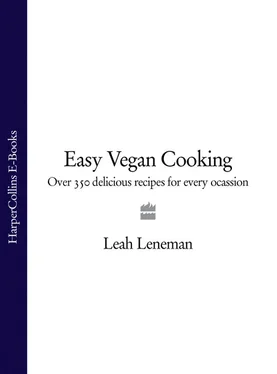
 Many cookery books state that imperial and metric measurements should not be mixed. As far as I am concerned, the recipes in this book are robust enough for imperial, metric and American measurements to be mixed at will. This is home cooking, not biochemistry.
Many cookery books state that imperial and metric measurements should not be mixed. As far as I am concerned, the recipes in this book are robust enough for imperial, metric and American measurements to be mixed at will. This is home cooking, not biochemistry.





